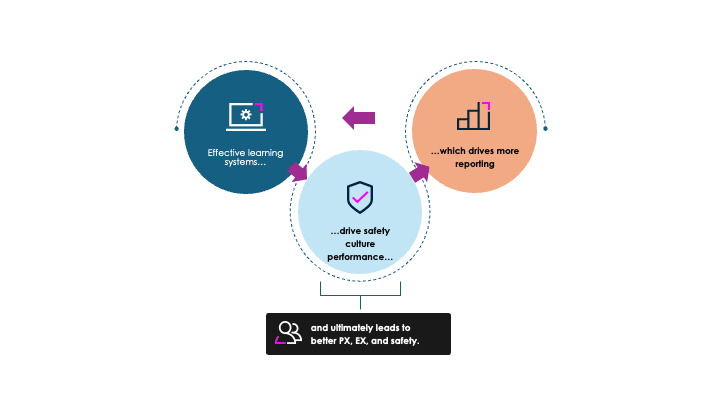Stronger learning. Safer culture. Better experience.
Coauthored by Heather Reed, Senior Director, Patient Safety Organization, Press Ganey.
When I led safety at Brigham and Women’s Hospital in the early 2000s, there was a push for increased event reporting. I soon learned, however, that the real challenge was acting on the quantity of reports we were already receiving. Often, staff didn’t report, fearing they’d be blamed. But perhaps even more often, I would hear that they just didn’t see the point. They had no idea what happened to their reports and doubted anything would change—i.e., the “black hole” of reporting.
I realized that our safety efforts needed to focus on effectively driving change based on those reports and making improvements visible. This resulted in a stronger safety culture where staff understand that reporting doesn’t, in fact, lead to blame or inaction, but rather results in learning and improvement that benefits everyone. This stronger safety culture, in turn, leads to more reporting, which can drive even more learning.
At Press Ganey, this cycle has become a driving force behind our work. We’ve long recognized that learning strengthens safety culture, safety culture promotes reporting, and reporting fuels deeper learning. Strong event reporting and learning have always been tied to better patient safety—it's why our safety culture surveys include an entire domain on “prevention and reporting," inquiring around things like if the organization is actively improving patient safety, if employees can report mistakes without fear, and if teams discuss error prevention. And this cycle, ultimately, leads to better outcomes.
Now, we have the data to prove it.
New data connects learning, safety, and experience
Improving safety starts with learning, but meaningful change happens when those learnings are shared and acted upon.
What we studied
In collaboration with our Patient Safety Organization (PSO) partners and Press Ganey High Reliability Platform (HRP) users, we conducted a comprehensive analysis of patient safety event reporting data. Our goal: to understand how effective learning ties to safety culture and reporting behavior, then connects to other outcomes like patient experience (PX).
How we did it
Using behavioral and operational data, we developed a predictive, multivariate model to estimate the expected number of safety events per facility. This model accounted for:
- Hospital type
- Case mix index
- Total acute care days
- Number of discharges
We then grouped facilities into two cohorts:
- Active reporting cohort (ARC): 219 facilities reporting events at or above the expected rate of reporting
- Limited reporting cohort (LRC): 68 facilities reporting events significantly below the expected rate
We also developed learning system measures in our High Reliability Platform—measures of how effectively organizations are learning from events and communicating the learnings to the reporters of the events and more broadly. These include:
- Percentage of cause analyses per serious safety event
- Strength of action plan items
- Time lag between reporting and feedback to the reporter
What we learned
Facilities in the ARC are more likely also have top quartile performance in safety for the following High Reliability Platform learning system measures:
- 3.4x more likely to be a top performer on “strength of backlogged action items per serious safety event”
- 2.2x more likely to be a top performer on "strength of completed action items per serious safety event”
- 1.7x more likely to be a top performer “cause analysis per serious safety event”
- 1.7x more likely to be a top performer for “root cause analysis per serious safety event”
A strong cause analysis program increases likelihood of event reporting
Looking at it in the opposite direction, organizations with top-quartile performance in the cause analysis learning system measures (and therefore with strong cause analysis programs) are more likely to be in the active reporting cohort:
- Root cause analysis per serious safety event: 33% more likely
- Cause analysis per serious safety event: 19% more likely
Importantly, organizations in the ARC also have a very strong correlation with strong safety culture. For example, those in the ARC are over 8x more likely to be top-quartile performers in the following safety culture measures:
- 9.1x stronger employee–manager collaboration for safety
- 8.4x more frequent learning from mistakes
- 8.3x stronger teamwork within units
- 8.2x higher perception of care quality
We know that safety culture performance strongly correlates with higher engagement, decreased turnover, better safety outcomes, and improved patient experience. In fact, organizations in the ARC show stronger PX performance on:
- 2.5x higher scores for hospital cleanliness
- 2.1x better teamwork among staff
- 2.0x more consistent communication about new medications
- 1.4x better attention to patient needs and discharge support
*Top quartile,-excluding PX items, is defined by top-quartile performance within the data set. PX items use top quartile by rank-. PX items show standard top-box rank for CAHPS items and custom top-box ranks for Press Ganey items.
Facilities where staff report more events are doing more than checking boxes. They’re building cultures of learning, transparency, and continuous improvement. They’re building cultures that translate directly into better outcomes for patients and caregivers alike.
Stronger learning. Safer culture. Better experience.

HRP vs. non-HRP: A clear advantage
Facilities using Press Ganey’s High Reliability Platform are more likely to be in the active reporting cohort. Why? Because HRP is designed to both capture events more easily and measure and optimize learning effectiveness.
HRP has robust tools to help with learning and optimizing performance on these metrics, including cause trending, cause analysis, and feedback to reporters functionality. We’re also continually expanding our capabilities. For example:
- Predictive modeling will provide expected case counts for benchmarking
- Human Experience (HX) safety analytics will link safety, experience, and culture data
- AI-powered workflows will enhance feedback loops and cause analysis
To learn more about Press Ganey’s High Reliability Platform and its powerful learning system, register for our November 12 High Reliability Learning Series webinar with Ardent Health.